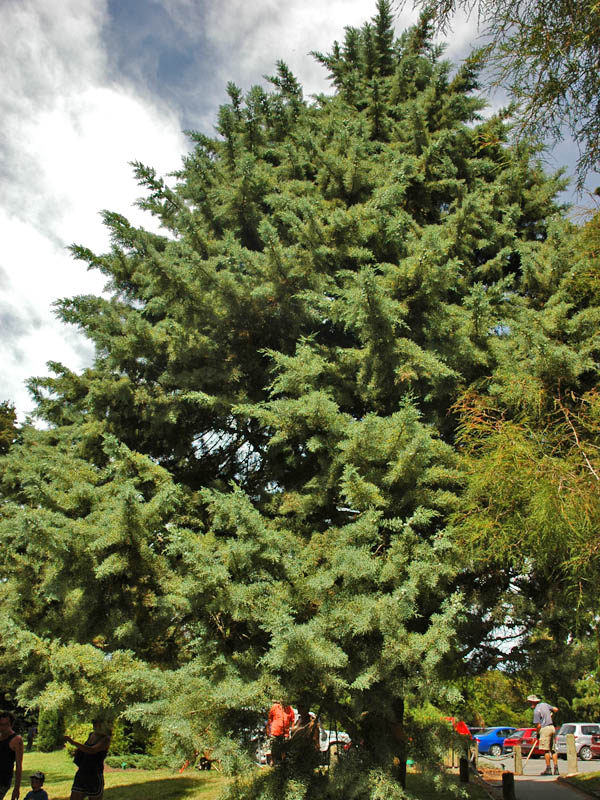| General Description | A medium-sized species of cypress that prefers hot and dry growing conditions. An attractive pyramidal-shaped tree, with shiny, red to brown, exfoliating bark. Many blue-foliaged cultivars have been created from Cupressus arizonica. |
| ID Characteristic | Dense, pyramidal medium-sized species. Needs hot, dry conditions for optimal growth. Attractive reddish-brown exfoliating bark. Spherical cones, with male and females growing on separate branches. |
| Shape | Pyramidal tree. More upright when young, and spreads with maturity. Dense crown. |
| Landscape | Can be used as a windbreak, tall screen, barriers, erosion control, as an ornamental or Christmas tree. Once it is established it can tolerate very dry and hot conditions, however it does not tolerate very low temperatures. Cupressus arizonica has a very attractive, pyramidal shape that is desirable in a landscape. Lumber from this tree can be very durable when it is seasoned. |
| Propagation | Propagation by seed is not often very successful but can be completed. Remove mature brown cones from tree and place in a warm, dry, shaded area away from animals. Allow the cones to dry out so that seeds fall out. Place seeds in a single layer in a container, cover with water and soak for 24 hours. Place the seeds, wrapped in a moist paper towel, into a sealed bag in the refrigerator for 30 days. Plant seeds in pots with soilless media. Keep soil moist, with indirect light and temperature of 23 °C. Germination should occur in 4-8 weeks. Keep indoors first winter then can be planted outdoors.
Ideal propagation method is by cuttings. On a soft, green stem, cut below a node (roughly 10-15 cm in length). Remove the bottom few leaves. Dip the stem in water and then rooting hormone. Place the stem 5 cm into a pot with potting soil mix. Keep warm and moist. Transplant the cutting in 3 weeks to a larger pot or the ground. |
| Cultivation | Full sun. Soil can be acidic, neutral or alkaline. Tolerates sandy, loam or clay soils. Needs well-drained soil. Prefers hot and dry conditions. Could be more prone to diseases in a more humid climate |
| Pests | Relatively pest-free if in ideal conditions and well cared for. However, can be susceptible to phomopsis, where new growth will turn yellow and eventually brown and die. This can be due to too much moisture in the soil. Cypress bark beetles have been noted as a potential problem in stressed trees, which would be due to improper growing conditions. |
| Notable Specimens | Many notable specimens (accession count of 10) can be seen on the campus of the University of Arizona, in Tucson, Arizona in the United States of America. |
| Habitat | Native to hot dry areas of the Southwestern United States and Northern Mexico. Prefers hot dry conditions, but not rocky soils. Found at the bottom of canyons, as well as on mountain slopes in pinyon-juniper woodlands and chapparal. |
| Bark/Stem Description | Gray to red-brown coloured. Mature bark shreds and exfoliates in long strips to expose reddish-brown bark. Older bark will reveal a fine, shallow furrowed pattern or mottled patchy look. |
| Flower/Leaf Bud Description | Evergreen leaves, therefore no leaf buds. Flower buds are immature male and female cones. Females are round, smooth and green in colour, forming at the end of the branchlet, in spring. Roughly 2.5 cm. Males are smaller, oblong-shaped and yellow in colour. |
| Leaf Description | Green, gray-green to blue-green colour. Evergreen scales closely overlapping, scale-like, flattened to branchlet, superposed in 4 rows about 1.58 mm long, acutely pointed. Foliage is soft-textured. Leaves clasp the stems in opposite and alternate arrangements. |
| Flower Description | Monoecious. Male small, yellowish oblong cones. Female subglobose cones. |
| Fruit Description | Female cones are globose, roughly 2.5 cm, with 4 to 8 slightly depressed peltate scales, each with a short mucro. Initially green turn to brown at maturity. Open at maturity, release winged seeds. Open cones can remain on branches for several years. Male cones are small and oblong. Female and male cones grow on separate branches of the same tree. |
| Colour Description | Green, to gray-green or blue-green foliage. Gray to brown young bark matures to exfoliating reddish-brown attractive bark. Yellow male cones. Green maturing to brown female cones. |
| Texture Description | Fine. Shredding bark texture with maturity. |
